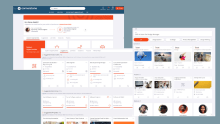Workforce transformation: Adoption of virtual talent strategies for the new world of work

Amid rapid workplace transitions pushed by the COVID-19-led disruption, skills and jobs have been deconstructed. Organizations and their leaders need a new fluid working model- agile human resources department to grasp the job requirements quickly, nimbleness and agility where project-specific skills are ascertained, employees are trained on them, and deployed to thrive in this business environment- all while working remotely at present and in a hybrid model in the future.
Outlined below are three talent focus areas that will undergo massive changes and the virtual strategies to accommodate the fluidity and agility of modern workplaces:
Recruitment
In this new tech-enabled economy powered by the industrial age 4.0, skills and capabilities define the new world of work. Organizations are in dire need of pivoting to this skill-based workplace transformation and hire people who are agile in learning new skills.
Companies must proactively map jobs to the competencies required to do that job. By leveraging pre-employment assessments they need to measure the individual’s behavioural, aptitude, domain and cognitive competencies, to deep-dive into the candidate’s core traits and acquired skills. These assessments are a critical measure of the real-world application and on-the-job performance of candidates.
As the next step, modern tools and platforms must be used to predict the future-readiness and learning agility of the individuals. These new-age digital tools lay bare the candidate’s agility to learn new skills ensuring organizations become resilient and adaptive to the changing business landscape and customer expectations.
Additionally, with traditional campus hiring getting challenging by the day, companies can take their entire process of hiring candidates- selection, screening, interviews, and onboarding- from campuses online. The end-to-end management of campus hiring processes like building campus intelligence, sorting the campuses, engaging the students with virtual activities, selection through online assessments, video interviewing, and post-hiring engagement can be successfully implemented and done online with the new-age platforms.
Learning and development
The economic recovery post-pandemic has been staggered with cycles of coronavirus-induced pandemic hitting the labour market at different times in the last 14 months or so. Skilling at this time needs to be transitioned at war footing for business and livelihood sustainability. The people left out of jobs because of the dip in sectoral demand in the industries like automotive, transport, hospitality, and travel can be absorbed by the surge in employment in other sectors. According to the World Economic Forum, there will be 50 million new tech jobs in the next five years.
Organizations need to map the skills that will go redundant and the competencies required for emerging jobs of tomorrow. Skill-gap analysis and training need identification will offer companies a comprehensive overview of what to train, who to train, and when to train.
There are other indices such as the skill-proximity index that analyzes the present skills of the employees and ascertain what new skills are most proximate to them. For example, an IT professionals with Java competency can quickly learn Node.JS, Vue, Flutter, and Django skills as well.
The leaders must also ensure the efficacy of learning and development programs offered to the employees. By measuring the advanced capabilities the training programs helped the individual build and the analysis of increased productivity and performance, future programs can be recalibrated.
The right suite of channels and processes should be set up to address any employee feedback and career orientation.
Identifying and engaging high potential employees is key to boosting critical talent retention.
Mental health and employee engagement
Companies also need to address the burgeoning pressure and mental-stress induced by social isolation and long hours of working. According to a global study on 2700 employees by Qualtrics and SAP across 10 industries, 75% of the respondents feel more socially isolated, 67% report higher stress, 57% face increased anxiety, and 53% are emotionally exhausted.
Supporting mental health is a business imperative currently. Companies need to plan and budget for anonymous counselling sessions, mental health helplines and kits such as paid meditation apps and live sessions.
We need new kinds of roles within the organizations that work towards driving open employee communication and foster more engagement. These job roles, such as engagement professionals, can be selected based on their higher level of soft skills like empathy and emotional intelligence. They should also be adept at making sense of the data flowing in from employee engagement platforms and tools employed in the company and suggest ways to adjust strategies.
Organizations can also employ modern engagement platforms like hackathons, ideathons, and case study competitions to keep the motivation and engagement levels high and always ensure there’s a sense of collaboration and coordination even in remote work settings.
Lastly, just like any other performance metric, employee engagement, has to be continuously measured through 360-degree feedback tools.
The new world of work will be different- aligned to talent strategies pivoted for a remote workforce and dependent to a significant degree on the collective efforts of people, organizations and government. The current environment allows us an opportunity to re-write the recruitment playbook by leveraging technology, which focuses not only on employee preferences but also unlocks cost savings & productivity gains. As new technologies continue to reshape how we work, it is incumbent upon employers to ensure employees’ skills are agile enough to adapt to the new sets of challenges that might be on the horizon and meet emerging demands.















